 Thayer's Gull (thayeri)
Thayer's Gull (thayeri)
(last update: January 22, 2013)
Thayer's Gull adult September
FEATURED PHOTO
-
VARIATION IN IRIS COLOR
OF ADULT THAYER'S GULLS -
JON R. KING AND STEVE N. G. HOWELL,
Point Reyes Bird Observatory, 4990
Shoreline Highway, Stinson Beach, California 94970
Iris color is sometimes useful in bird identification. especially for gulls. A frequently quoted example is the separation of adult Herring (Larus argentatus smithsonianus) and Thayer's [L. (glaucoides?) thayeri] gulls. Typically, adult Herring Gulls have "staring" unmarked pale yellow irides, adult Thayer's Gulls dark irides, a view supported by numerous publications (e.g., Gosselin and David 1975, Lehman 1980, Grant 1986, Zimmer 1990, 1991). Each of these references, however, mentions that some adult Thayer's Gulls show paler irides with dark markings (e.g., "brown fiecking in a pale iris," Grant 1986) but imply that such birds are infrequent. Zimmer (1990) wrote that the irides of adult Thayer's Gulls that are relatively pale still "appear solidly brown at any real distance," Grant (1986) that "none has (an) entirely clear yellow iris. On a single vagrant adult in Ireland, McGeehan and Millington (1998) noted a pale iris with brown flecking, which nevertheless appeared dark without a telescope view.
While studying gulls in the winters of 1996/97 and 1997/98, we found iris color in adult Thayer's Gulls to be highly variable, and from December 1997 to March 1998 we attempted to quantify this variation. At several sites in central California (Marshall and Bolinas, Marin Co.: Petaluma, Sonoma Co.; Hidden Lake and Lake Cunningham, Santa Clara Co.) we recorded the iris colors of 104 adult Thayer's Gulls by means of the following scale:
0.0, iris uniformly dark brown (as typical of a California Gull, L. californicus);
0.5, medium brown (as in a juvenile or first-winter Thayer's Gull);
1.0, pale brown or honey-colored (as typical of an adult Mew Gull, L. canus brachyrhynchus);
1.5, dusky, greenish, or dark yellow or amber, extensively mottled brown);
2.0, pale green or yellowish moderately marked with brown; 2.5, pale green or yellowish, lightly speckled with brownish;
3.0, unmarked yellowish (as typical of an adult Herring Gull).
We found that close views are normally required for exact determination of iris color and pattern, a fact that readers should bear in mind when attempting to apply our results. We made our observations under overcast skies to minimize the effect of direct sunlight, and we frequently cross-checked our observations. When we considered an iris color intermediate between two scores, we rounded it down to the darker of the two scores, hence our results slightly underestimate the average paleness of adult Thayer's Gulls' eyes.
| Score | December | January | February | March | Total |
| 0.0 | 0 | 1 | 1 | 0 | 2 |
| 0.5 | 3 | 1 | 3 | 0 | 7 |
| 1.0 | 12 | 2 | 4 | 1 | 19 |
| 1.5 | 15 | 0 | 10 | 2 | 27 |
| 2.0 | 11 | 0 | 10 | 0 | 21 |
| 2.5 | 16 | 1 | 5 | 1 | 23 |
| 3.0 | 5 | 0 | 0 | 0 | 5 |
| Total: | 62 | 5 | 33 | 4 | 104 |
Table 1 Iris scores of Adult Thayer's Gulls in Central Calfornia by Month
Our findings. summarized in Table 1, suggest that adult Thayer's Gulls more frequently show pale irides than appears to have been described previously. Most of the adult Thayer's Gulls we observed (87%) showed either pale brown irides or yellow or green irides with varying degrees of brownish mottling (scores 1.0-2.5). A significant proportion (27%) had largely pale irides (scores 2.5 or 3.0) that superficially resembled those of an adult Herring Gull even at distances greater than 20 m. Five percent showed irides that could not be separated by color or pattern from those of a typical Herring Gull (score 3.0). Only 9% of our sample showed irides that were wholly dark or medium brown (scores 0 or 0.5). Our data indicate that a yellow-green base color of the iris. variably mottled or speckled with brownish, is actually fairly common in adult Thayer's Gulls: thus, the literature appears to overstate the reliability of iris color as a character distinguishing adult Thayer's and Herring gulls.
Although the data are rather limited, we found no clear evidence of a seasonal change in iris color. We hope that further study will reveal to what extent, if any, adults' iris color changes with reproductive condition and/or season, and the age at which Thayer's Gulls can start to show pale irides (rarely, a score of 2.5 can be reached by Thayer's Gulls in their second winter; King, pers. obs.).
The adult Thayer's Gull featured on the back cover was photographed by King at Marshall, Marin Co., California, on 20 December 1997. At long range (> 30m) in good light, this individual showed a "staring" yellowish iris, reminiscent of an adult Herring Gull. Closer inspection (down to 20 m) revealed very restricted fine brownish mottling on a yellowish iris (a score of 2.5). Other characters visible in the photograph supporting the identification of this bird as an adult Thayer's Gull are its relatively small body size, rounded head, medium gray upperparts, rather smudged dusky head and neck markings, rather small bill lacking a prominent gonydeal angle, dull yellow basal half of the bill, prominent purplish red orbital ring, and matt rather than jet black markings on the primary tips.
Adult Thayer's Gulls can also resemble the occasional adult Kumlien's [Iceland] Gulls [L. (glaucoides?) kumlieni] that show blackish primary markings. The iris of the adult Kumlien's Gull is generally described as variable, ranging from clear yellow to dark (Lehman 1980) or as "golden, amber, or even, rarely, brown" (Millington 1993). Therefore, while the iris of adult Thayer's Gull may average darker than that of Kumlien's Gull, we expect substantial overlap; a study of iris color in Kumlien's Gull similar to ours would help clarify the extent of this overlap.
We thank Stephen C. Rottenborn for his review. This is contribution 854 of the Point Reyes Bird Observatory.
LITERATURE CITED
Gosselin, M., and David, N. 1975. Field identification of Thayer's Gull (Larus thayeri) in eastern North America. Am. Birds 29:1059-1066.
Grant, P. J. 1986. Gulls: A Guide to Identification, 2nd ed. Academic Press, San Diego.
Lehman, P. 1980. The Identification of Thayer's Gull in the field. Birding 12:198-210.
McGeehan, A., and Millington, R. 1998. The adult Thayer's Gull in Donegal. Birding World 11:102-108.
Millington, R. 1993. Identification and status of Kumlien's Gull. Birding World 6:101-106.
Zimmer, K. J. 1990. The Thayer's Gull complex, in Advanced Birding (K. Kaufmann, ed.), pp. 114-130. Houghton Mifflin, Boston.
Zimmer, K. J. 1991. Plumage variation in "Kumlien’s" Iceland Gull. Birding 23:254-269.
 Thayer's Gull adult T4 September 27 2012, Whitehorse, Yukon, Canada. Picture: Cameron Eckert.
Thayer's Gull adult T4 September 27 2012, Whitehorse, Yukon, Canada. Picture: Cameron Eckert. Thayer's Gull adult, September 27 2008, Clover Point, Victoria, BC. Picture: Robert Doiron.
Thayer's Gull adult, September 27 2008, Clover Point, Victoria, BC. Picture: Robert Doiron. Thayer's Gull adult, September 10 2012, Teslin Lake, Yukon. Picture: Yukon Bird Observatories.
Thayer's Gull adult, September 10 2012, Teslin Lake, Yukon. Picture: Yukon Bird Observatories.Identification and Variation of Winter
Adult Thayer’s Gulls
with Comments on Taxonomy
EYE COLOUR
 Scoring = 0.0, iris uniformly dark brown.
Scoring = 0.0, iris uniformly dark brown.Thayeri, Capitola, CA. Picture: Jeff Poklen.
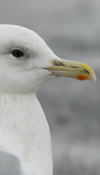 Scoring = 0.5, medium brown.
Scoring = 0.5, medium brown.Kumlieni, Newfoundland. Picture: Dave Brown.
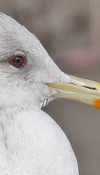 Scoring = 1.5, dusky, greenish, dark yellow, or amber, extensively mottled brown.
Scoring = 1.5, dusky, greenish, dark yellow, or amber, extensively mottled brown.Thayeri, Capitola, CA. Picture: Jeff Poklen.
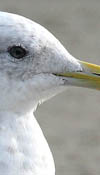 Scoring = 1.5, dusky, greenish, dark yellow, or amber, extensively mottled brown.
Scoring = 1.5, dusky, greenish, dark yellow, or amber, extensively mottled brown.Thayeri, Rio del Mar, CA. Picture: Jeff Poklen.
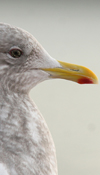 Scoring = 1.5, dusky, greenish, dark yellow, or amber, extensively mottled brown.
Scoring = 1.5, dusky, greenish, dark yellow, or amber, extensively mottled brown.Kumlieni, Newfoundland. Picture: Dave Brown.
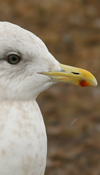 Scoring = 1.5, dusky, greenish, dark yellow, or amber, extensively mottled brown.
Scoring = 1.5, dusky, greenish, dark yellow, or amber, extensively mottled brown.Kumlieni, Newfoundland. Picture: Dave Brown.
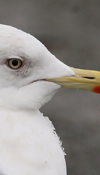 Scoring = 2.0, pale greenish or yellowish, moderately marked with brown.
Scoring = 2.0, pale greenish or yellowish, moderately marked with brown.Kumlieni, Newfoundland. Picture: Dave Brown.
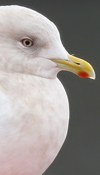 Scoring = 2.5, pale greenish or yellowish, with little or no brown mottling visible.
Scoring = 2.5, pale greenish or yellowish, with little or no brown mottling visible.Kumlieni, Newfoundland. Picture: Dave Brown.
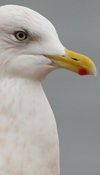 Scoring = 2.5, pale greenish or yellowish, with little or no brown mottling visible.
Scoring = 2.5, pale greenish or yellowish, with little or no brown mottling visible.Kumlieni, Newfoundland. Picture: Dave Brown.
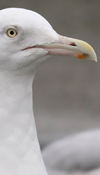 Scoring = 3.0, apparently unmarked pale yellowish (like an adult Herring Gull).
Scoring = 3.0, apparently unmarked pale yellowish (like an adult Herring Gull).Hyperboreus, Newfoundland. Picture: Dave Brown.
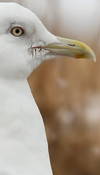 Scoring = 3.0, apparently unmarked pale yellowish (like an adult Herring Gull).
Scoring = 3.0, apparently unmarked pale yellowish (like an adult Herring Gull).Glaucoides, Newfoundland. Picture: Dave Brown.
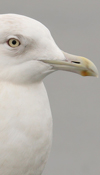 Scoring = 3.0, apparently unmarked pale yellowish (like an adult Herring Gull).
Scoring = 3.0, apparently unmarked pale yellowish (like an adult Herring Gull).Glaucoides, Newfoundland. Picture: Dave Brown.